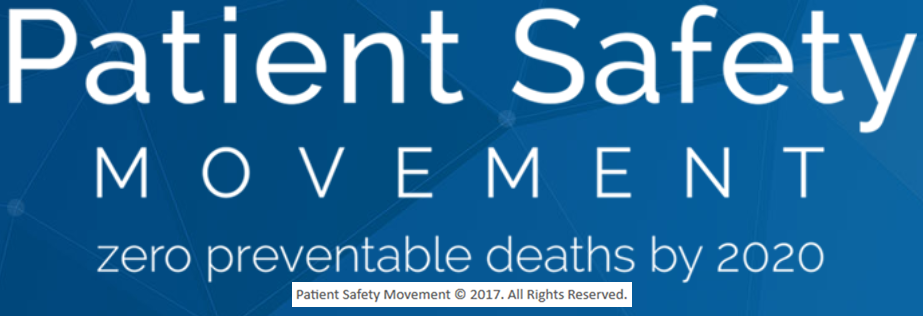
N.B. — This post is based on one of the continuously expanding roster of Actionable Patient Safety Solutions (APSS) a.k.a. “Challenges” as defined and described by the Patient Safety Movement Foundation (PSMF) and published at its web site (http://patientsafetymovement.org/challenges-solutions/actionable-patient-safety-solutions-apss/). Because the Foundation has set a goal of Zero Preventable Patient Deaths by 2020 (http://patientsafetymovement.org/), these APSS are understood to represent the most significant patient safety exposures created by medical mistakes, and medical mistakes are the third most frequent cause of patient deaths following heart disease and cancer (http://www.bmj.com/content/353/bmj.i2139).
“[The essential Executive Summary elements for effective sepsis management are:]
- Commitment from hospital governance and senior administrative leadership to support early detection and appropriate management of sepsis in their healthcare system.
- Develop a team approach to implement a protocol for early sepsis identification and treatment.
- Create a sepsis dashboard for your organization’s leadership.
- Implement a Sepsis Rapid Response Team or incorporate early detection of sepsis into your existing medical emergency teams (e.g. rapid response teams).
- Formalize a process to screen patients for signs of sepsis throughout the entire institution.
- Implement an effective monitoring system to accomplish continuous monitoring and notification based on acute changes to the following patient data:
- Fever (> 38.3°C); Hypothermia (temperature < 36°C);
- Heart rate > 90/min or 1 or more than two standard deviations above the normal value for age;
- Tachypnea (RR > 20);
- Altered mental status;
- Hyperglycemia (plasma glucose > 140 mg/dL or 7.7 mmol/L) in the absence of diabetes;
- Leukocytosis (WBC count > 12,000 μL–1); Leukopenia (WBC count < 4000 μL–1); Normal WBC count with greater than 10% immature forms;
- Plasma C-reactive protein more than two standard deviations above the normal value;
- Plasma procalcitonin more than two standard deviations above the normal value;
- Hypotension (SBP < 90 mm Hg, MAP < 70 mm Hg, or an SBP decrease > 40 mm Hg in adults or less than two standard deviations below normal for age); Hypoxemia (Pao2 < 60 mmHg or Sp02 < 90%);
- Acute oliguria (urine output < 0.5 mL/kg/hr. for at least 2 hrs. despite adequate fluid resuscitation);
- Creatinine increase > 0.5 mg/dL. or 44.2 μmol/L;
- Coagulation abnormalities (INR > 1.5 or aPTT > 60 sec);
- Thrombocytopenia (platelet count < 100,000 μL–1);
- Hyperbilirubinemia (plasma total bilirubin > 4 mg/dL or 70 μmol/L);
- Hyperlactatemia (> 2 mmol/L); or
- Prolonged capillary refill time or mottling.
- Select an EHR to serve as a data collection tool and repository for predicting risk of sepsis for patients. A system that provides a data collection tool and allows for continuous analysis and surveillance will be most beneficial.
- Implementation of automated electronic screening based on existing data (SIRS criteria, MEWS or any other warning system being used).
- Design a workflow specific to level of alert:
- SIRS met – assess for infection.
- If patient has sepsis – increase monitoring or assessment for presence of severe sepsis.
- Implement a process for continuous monitoring of electronic systems and protocols:
- Compliance, efficacy and outcome measures.
- Implement case reviews for outliers.
- For severe sepsis:
- Implement workflow for rapid assessment and intervention at the bedside.
- Initiate severe sepsis bundle (3 hour elements):
- Measure lactate level.
- Obtain blood cultures prior to administration of antibiotics.
- Administer broad spectrum antibiotics.
- Administer 30 mL/kg Crystalloid for hypotension or lactate ≥4 mmol/L.
- Build electronic documentation of process of care (fluids, antibiotics, clinical assessment etc.).
- For septic shock:
- Implement workflow for rapid assessment, intervention and need for higher level of care.
- Initiate septic shock bundle (6 hour elements):
- Apply vasopressors (for hypotension that does not respond to initial fluid resuscitation to maintain a mean arterial pressure (MAP) ≥65 mm Hg).
- In the event of persistent hypotension despite volume resuscitation (Septic Shock) or initial lactate ≥4 mmol/L (36 mg/dL):
- Measure central venous pressure (CVP).
- Measure central venous oxygen saturation (ScvO2).
- Measure central venous pressure (CVP).
- Remeasure lactate if initial lactate was elevated.”
The foregoing quote constitutes the “Executive Summary Checklist” from the above-captioned PSMF APSS Challenge #10 (http://patientsafetymovement.org/challenge/early-detection-of-sepsis/). Although all the elements are appropriate and empirically based, the critical elements for reliable mistake mitigation and sepsis-related patient adverse event avoidance are:
“Implement an effective monitoring system to accomplish continuous monitoring and notification based on acute changes to the following patient data …”; and
“Select an EHR to serve as a data collection tool and repository for predicting risk of sepsis for patients. A system that provides a data collection tool and allows for continuous analysis and surveillance will be most beneficial …”
The critical nature of these elements stem from the extremely time-dependent nature of sepsis detection and the importance of early detection and intervention to arrest the typically rapid progression of sepsis to severe sepsis and then to septic shock. Please validate this proposition to your own satisfaction by reviewing the details of the Cloud Healthcare Appliance Real-Time Solution as a Service (CHARTSaaS) and its reference architecture in these presentations, and then by imagining a CHARTSaaS-enabled IT solution: